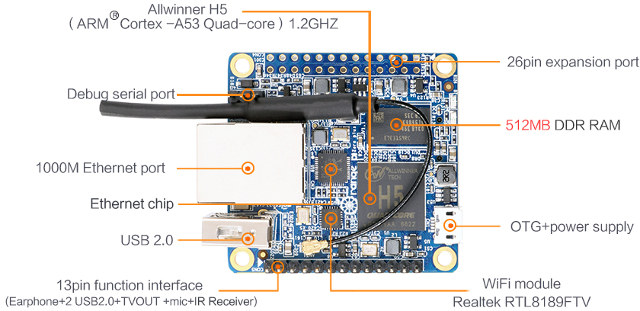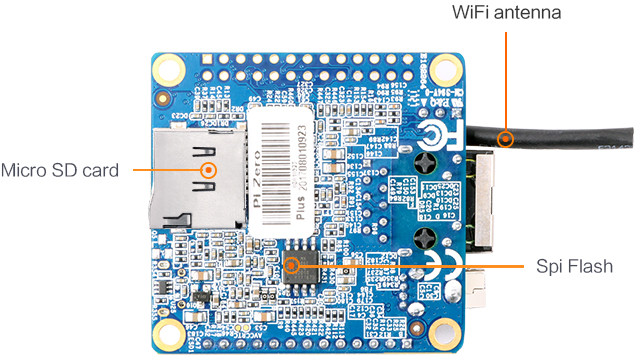We had Orange Pi Zero, followed by Orange Pi Zero Plus 2, then Orange Pi Zero Plus 2 H5, but now there’s another “Zero” model that’s called Orange Pi Zero Plus, which like Orange Pi Zero Plus 2 H5 board is based on Allwinner H5 processor, but adds a faster Gigabit Ethernet port, and offers a fairly different features set compared to the first Orange Pi H5 board, albeit in the same form factor.

Orange Pi Zero Plus specifications with highlights in bold and stricken-through showing difference with Orange Pi Plus 2 H5 model:
- SoC – Allwinner H5 quad core Cortex A53 processor with hexa core Mali-450MP4 GPU
- System Memory – 512 MB DDR3
- Storage –
8GB eMMC flash, micro SD card slot + 2MB SPI flash - Video Output –
HDMI; AV port via 13-pin header - Connectivity – Gigabit Ethernet, 802.11 b/g/n WiFi (Realtek RTL8189FTV) with u.FL antenna connector and external antenna. No Bluetooth
- USB – 1x micro USB OTG port, 1x USB 2.0 host port
Camera – MIPI CSI port- Expansion headers
- Unpopulated 26-pin “Raspberry Pi B+” header
- 13-pin header with headphone, 2x USB 2.0, TV out, microphone and IR receiver signals
- Debugging – 3-pin serial console header
- Misc – 2x LEDs for power and status
- Power Supply – 5V via micro USB port
- Dimensions – 48 x 45 mm
- Weight – 26 grams
The eMMC flash is gone, but has been replaced with an SPI flash that should allow for network boot without micro SD card. HDMI output is gone, so your only video output option would be via the video composite signal on the 13-pin header. Bluetooth is gone as they replaced the Ampak module by a Realtek one, and the camera connector. All those differences means the two Orange Pi H5 boards have different uses case, with the new board is better suited to headless application where you need Gigabit Ethernet connectivity, and potentially want to save a few dollars on the board price, and remove the need for storage (if you use network boot).
 The board should also be compatible with Orange Pi Zero NAS expansion board, so you’d have an inexpensive micro NAS with performance and price that rivals with FriendlyELEC NanoPi NEO 2 NAS kit, minus the enclosure. 2017 has been an exciting year for affordable networked storage so far, with various options from the two lower-end solutions aforementioned, to the better upcoming ODROID-MC1, and the higher end EspressoBin board, with some interesting work also taking place on ROCK64 board.
The board should also be compatible with Orange Pi Zero NAS expansion board, so you’d have an inexpensive micro NAS with performance and price that rivals with FriendlyELEC NanoPi NEO 2 NAS kit, minus the enclosure. 2017 has been an exciting year for affordable networked storage so far, with various options from the two lower-end solutions aforementioned, to the better upcoming ODROID-MC1, and the higher end EspressoBin board, with some interesting work also taking place on ROCK64 board.
Software-wise, it may be worth noting that there’s no stable Armbian build so far, but there are experimental Ubuntu Xenial images for Orange Pi Zero 2 H5 board with mainline Linux kernel, which should work on the new board by just changing the DTB file. However, I did use NanoPi NEO2 with Allwinner H5 as a OpenMediaVault NAS, and it worked well enough, so I would not worry too much about software support for this use case. I’m not sure about U-boot support in the SPI flash, but hoping for some feedback in the comments section.
Orange Pi Zero Plus is sold for $14.90 plus shipping ($18.29 in total here). If you’re interested in mini NAS / home cloud system, you’ll need to add the NAS expansion board for $6.98, which in my case brings the total to $27.13 including shipping. A direct comparison with NanoPi NEO2 NAS kit is not possible, since Shenzhen Xunlong micro NAS solution does not include a case, nor heatsink, but for reference, a complete NAS kit v1.2 with NEO2 board goes for $28.98 plus shipping, or $44.98 in total in my case.

Jean-Luc started CNX Software in 2010 as a part-time endeavor, before quitting his job as a software engineering manager, and starting to write daily news, and reviews full time later in 2011.
Support CNX Software! Donate via cryptocurrencies, become a Patron on Patreon, or purchase goods on Amazon or Aliexpress




